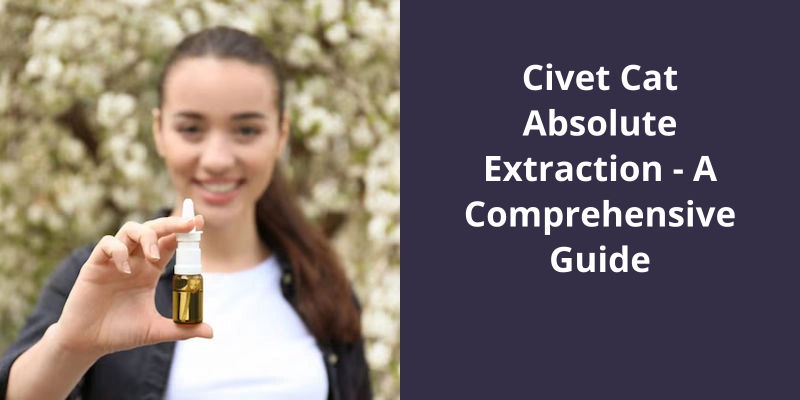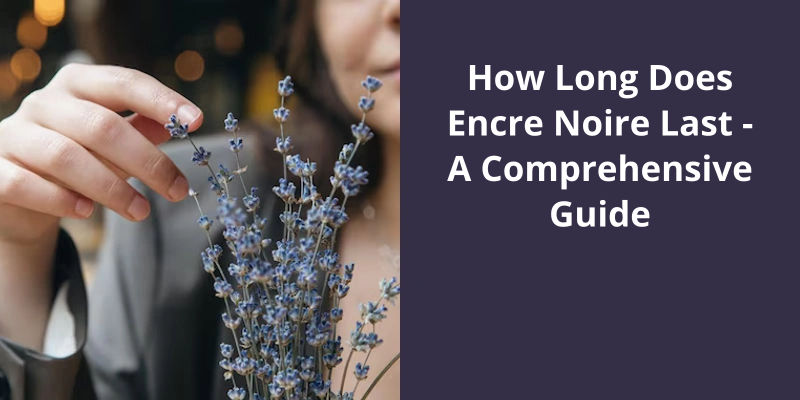Civet Cat Absolute Extraction is a process used to obtain highly valuable perfume ingredient from the African civet cat. Specifically, the substance, known as civet, is a glandular secretion produced by the animal. Usually, it’s manually collected from the glands of the captive cat; once secreted, the thick paste ferments and forms a strong musky fragrance. This raw substance is then taken through an extensive purification process which involves solvents like alcohol to produce ‘civet absolute’. This highly-concentrated aromatic compound is then used sparingly in perfumery to give depth and warmth to fragrances. However, due to ethical and animal welfare concerns, synthetic alternatives to civet are now preferred in modern perfumery.

Where Do Civet Cat Absolute Come From?
The Civet cat absolute is a highly prized fragrance material that’s captivated the perfumery industry for centuries. This scent is obtained from the secretions of the male and female Civet cats, which belong to the Viverridae family. Despite it’s name, Civet cats aren’t actually felines; they’re a unique species that’s native to parts of Africa and Asia.
It’s interesting to note that although the Civet cat absolute is often associated with African origin, it’s actually sourced from India. The Indian Civet cats are known for producing some of the most potent and high-quality Civet absolute in the world. The material is collected from the secretions of these cats and is a solid waxy mass, which is golden brown in color.
The scent is often described as rich, exotic, and sensual, and it’s used in a variety of fragrance blends, such as oriental and chypre perfume styles.
The harvesting of Civet absolute is a delicate process that requires great care and attention. The Civet cats aren’t harmed during the collection process, and only a small amount of the secretion is taken from each animal to ensure their well-being. Once collected, the secretion is purified and processed to create the Civet absolute that’s used in perfumery.
While Civet absolute is a highly prized material in the fragrance industry, it’s use has also been controversial due to the ethical concerns around animal welfare. Thankfully, synthetic alternatives have been created that mimic the scent of Civet absolute without the need to harm animals.
History of Civet Cat Absolute in Perfumery
- The history of Civet cat-based absolute in perfumery dates back to ancient times when ancient Egyptians used it in their perfumes.
- Civet cat absolute is obtained from the musk glands of the African Civet cat.
- The musk from the glands is collected and then processed to obtain the purest form of Civet cat absolute.
- The use of Civet cat absolute in perfumery faced controversy due to the inhumane methods used for collecting the musk from the Civet cat glands.
- Today, synthetic Civet cat absolute is used instead of the natural one to avoid any harm to animals.
- Civet cat absolute is still used in many high-end perfumes due to it’s unique and exotic fragrance.
However, in the perfume industry, civet is no longer harvested from live animals due to ethical concerns. Instead, synthetic or plant-based alternatives are used to replicate the unique scent of civet in fragrances.
How Is Civet Made?
Civet has been used in perfumes since ancient times and was highly prized for it’s musky scent. In the past, the process of obtaining civet was quite brutal and involved trapping the animals and extracting the substance by force. However, nowadays, ethical sources of civet have been developed.
The process of obtaining civet now involves allowing the civet to live freely and marking trees with materials that contain a synthetic form of the substance produced by the gland, which causes the civet to rub against it, leaving their natural civet on the material. This paste is then collected and processed further, resulting in the final product. This process is more humane and sustainable than the historical practices.
However, due to the ethical concerns and the availability of natural alternatives, the use of natural civet has declined.
Nowadays, synthetically produced civet is available, which produces the same aroma but without the harm to animals.
The History of Civet in Perfumery It’s Use and Significance Through the Ages
Civet has been used in perfumery for centuries due to it’s unique and long-lasting fragrance. It’s obtained from the anal glands of the civet cat, although synthetic versions are now more commonly used. Despite it’s popularity, the use of civet in perfumes has been controversial due to animal welfare concerns. Over time, the significance of civet in perfumery has evolved, with changes in cultural perceptions and advances in technology leading to alternative ingredients being used.
Moving away from bizarre food additives and onto the topic of natural ingredients, it’s worth exploring some of the unusual sources from which certain products are derived. One such example is civet absolute, which is known for it’s distinct musky scent and is used in a variety of perfumes and skincare products. But where exactly does this ingredient come from, and what makes it such a sought-after commodity? Let’s take a closer look.
What Part of the Body Does Civet Cat Absolute Come From?
Civet cat absolute is a highly valued material used in perfumes and fragrances. It’s known for it’s rich, earthy scent that’s both exotic and sensual. However, many people aren’t even aware of where civet cat absolute comes from. The truth is, this precious substance is extracted from the anal glands of the civet cat, a small, nocturnal mammal native to Africa and Asia.
The extraction process of civet cat absolute is a delicate and laborious one. It involves scraping the secretion from the glands of the civet cat and then subjecting it to various treatment methods.
Another curious substance that comes from an animals secretions is the beavers sacs. This ingredient is found in some food products, particularly in artificial flavorings used in processed foods. The sacs release a yellowish substance that’s used to mark the beavers territory. This substance, though seemingly obscure, has been used for centuries as a flavoring agent, especially in baked goods, frozen dairy desserts, and gelatins.
However, the use of animal secretions in food and cosmetics has been a controversial topic for years. Many people are concerned about the ethical implications of using animal materials in products, while others raise concerns about the potential health risks associated with these ingredients. Nevertheless, the use of animal-derived ingredients in products remains prevalent in certain industries, sparking debate and controversy among consumers.
The History and Cultural Significance of Civet Cat Absolute in Perfume-Making.
- Civet cat absolute is a rare ingredient in perfume-making that’s been used for centuries.
- It comes from the secretions of the African civet cat, which are collected in a cruel and inhumane process.
- Despite it’s controversial origins, civet cat absolute has been prized for it’s unique and potent musky scent.
- It was a popular ingredient in perfumes during the 19th and early 20th centuries, but it’s use has declined in recent years due to ethical concerns.
- Many perfumers now use synthetic substitutes or other animal-derived ingredients to replicate the scent of civet cat absolute.
Source: Civet
Now that we’ve learned about the process of obtaining civet perfume, it’s important to understand the historical significance and cultural implications of this luxury item.
Where Does Civet Perfume Extract From?
Civet perfume, also known as civet musk, is a highly sought-after fragrance ingredient that’s been used for centuries in perfumes, soaps, and cosmetics.
Civet musk is extracted from the anal glands of the civet cat. Civets are small, nocturnal mammals that are native to parts of Asia and Africa. In Ethiopia, civets are found in the wild, then caught and kept in captivity. The musk is collected by squeezing a pair of perineal glands on the civets backside. This process is usually done by hand, and the musk is collected on cotton swabs or spatulas.
Many perfume houses and consumers have moved away from using animal products in fragrances, and alternatives to civet musk have been developed. Synthetic musks, such as galaxolide and musk ketone, have been developed to mimic the scent of natural musk, while vegan-friendly alternatives like castoreum and ambergris are also used in fragrances.
It’s unique and powerful scent is unlike anything else in the fragrance world, and it’s inclusion in a fragrance can add a sense of luxury and exclusivity.
The History and Cultural Significance of Civet Perfume in Different Parts of the World
Civet perfume, made from the glandular secretions of civet cats, has a long and complex history in many cultures. In ancient times, civet was used in perfumes and as a medicine. In some cultures, it was considered an aphrodisiac and was used in love potions. Today, civet perfume is still prized in some parts of the world, particularly in the Middle East and parts of Asia. Despite it’s cultural significance, the use of civet in perfumes has become controversial due to animal welfare concerns.
Now that we know what civet paste is and where it comes from, let’s take a closer look at how it’s made. The process involves a careful blend of traditional techniques and modern technology, with a lot of attention paid to the sourcing of civet secretions.
How Is Civet Paste Made?
The process to obtain civet paste begins with capturing the civet cat from it’s natural habitat. In the past, this involved hunting wild civets, but today, most of the civets used for their secretion are bred in captivity. These captive civets are fed a diet of coffee berries, which are believed to give the paste it’s unique aroma and flavor.
Once the civet has produced the secretion, workers collect it from the animals perineal glands. Historically, the workers would have manually harvested the paste by squeezing the glands, but now many producers use a vacuum siphon to remove the secretion. The paste is collected into a container and is then transported to a processing facility to be prepared for sale.
The first step in processing the civet paste is to wash it thoroughly to remove any impurities. Next, the paste is ground into a fine powder and mixed with a carrier oil, such as coconut or jojoba oil, to make it easier to use. The oil also helps preserve the paste and extend it’s shelf life.
Once the paste is blended with carrier oil, it’s ready for use in various fragrances and perfumes. The usage of civet in fragrances has been controversial due to the ethical and animal welfare concerns that surround obtaining the paste from the civet cat. In recent years, the beauty and fragrance industry has largely shifted away from using civet paste, with natural and synthetic alternatives being developed as a more ethical option.
The History of Civet Paste and It’s Use in Traditional Medicine
Civet paste is a substance made from the secretions of African palm civets and has been used in traditional medicine for centuries. It was believed to have health benefits and used for everything from treating skin conditions to digestive issues. However, the harvesting of civet paste has been controversial and inhumane, as it often involves trapping and caging civets for their secretions. Today, many countries have banned the use and trade of civet paste to protect the welfare of these animals.
Aside from it’s use in the fragrance industry, civet cat has also made it’s way into various food and tobacco products. Interestingly, it’s been utilized as an ingredient in food additives that give off distinct flavorings such as butter, caramel, and rum. In addition, it can also be found as one of the lesser-known components of cigarettes.
Is Civet Cat Absolute in Butter?
The use of Civet cat in food additives has been a topic of much controversy in recent years. Many animal rights advocates are opposed to it’s use, claiming that it’s cruel and unnecessary. However, the substance has a long history in the food industry, and has been used for centuries to add flavor to a variety of sweets and desserts.
One of the reasons civet cat extract is so sought after is because of it’s unique aroma and taste. It’s a rich, buttery flavor that’s often described as being similar to caramel or rum. This flavor profile is ideal for use in a wide range of baked goods, chocolates, and other confections.
It’s sometimes used as a fragrance in perfumes and colognes, and is also used in some traditional medicines.
Despite the concerns surrounding the use of civet cat extract, it’s unlikely that it will be banned anytime soon. Many people enjoy it’s unique flavor and aroma, and it remains an important ingredient in many traditional recipes and products.
Conclusion
The practice of civet cat absolute extraction isn’t only cruel and inhumane, but it also poses a serious threat to the conservation of the civet cat species. The use of live civet cats in the production of perfume and other fragrance products isn’t only unnecessary, but it also perpetuates the unethical treatment of animals for human gain. As consumers, it’s important to be mindful of the products we purchase and their impact on the environment and animal welfare. Ultimately, it’s our responsibility to make informed and ethical choices to promote a sustainable and compassionate future.





